Ubuntu and Linux Mint are two popular Linux distros available in the Linux community. Ubuntu is a derivative of Debian, and on the other hand, Linux Mint is developed based on Ubuntu LTS. Though both the distros are quite an excellent choice for the newbie and support a wide range of modern devices, there are still some differences for which an array of users may want to compare as Linux Mint vs. Ubuntu digging out the right reasons to choose. Further, just describing these distros, I would like to hit the bull of the deciding factor to compare Linux Mint vs. Ubuntu. It helps you as new Linux users or users who want to shift from Windows or macOS and get the best OS alternative.
Linux Mint or Ubuntu, Which one is Better?
In this comparison article, I am not going to start a battle (Linux Mint vs. Ubuntu) on finding the answer to the queries of which one is best for newcomers; rather, I will show you some overriding factors which will help you guys to fit yourself according to the choices.
Before going into the details, I would like to mention for whom this article is developed. A good number of users regularly search online for “Best Linux Distros for Beginner.” There are no specific answers for solving this question because choosing the best distros or OS depends on users’ needs. So there is nothing called – best Linux distro.
Two camps ask the best Linux distros for a newbie. One camp is tech-savvy tweakers, knows a lot about technology, computer and now desires to explore Linux for the first time and likes the concept of open source software movement.
On the other hand, another camp doesn’t know much about Linux but wants to install a fresh copy on old hardware to give a new life or shift from Windows or Mac and get the taste of freedom. These guy doesn’t care about customization or tweaks on Linux, and they want a better and smoother computing experience. Before going to the main discussion, you can check out my latest comparison article on Debian vs. Ubuntu.
Linux Mint vs. Ubuntu: Deep Down into the Core
Both the distros are forked of the Debian system and have lots of things in common. However, they have approached a different path to fulfill the user’s needs. Linux Mint is an excellent alternative to Windows OS, and Ubuntu is more about competing with the Mac system. Besides all these differences, you can make these Linux distros as like as you want with a few tips and tricks, and that’s the beauty of Linux – ensuring freedom all the way. Now it’s time to deep down into the core of Linux Mint vs. Ubuntu comparison and see the overriding factors.
1. System Requirements
Both systems run on a wide range of devices, but Ubuntu demands a bit more power than Linux Mint. Ubuntu Gnome version offers sleek modern design and stunning visual effects, but Linux Mint is old-fashioned and runs on current and old hardware. Ubuntu Gnome requires more power and resources, but Linux Mint demands a bit lower than Ubuntu.
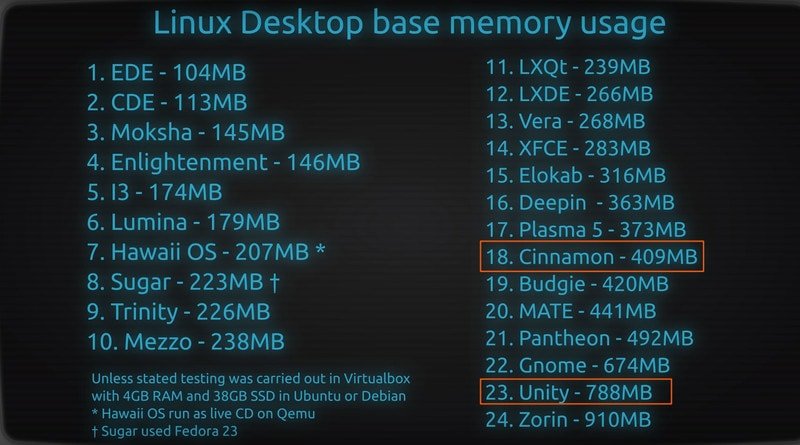
2. System Installation Process
Installation methods for both the distros are quite the same and easy. Linux Mint and Ubuntu both support the Ubiquity installer method and UEFI.
3. Basic Interface
Linux Mint comes with various Linux desktop environments, but Cinnamon is the default one. This DE is like a Windows interface with the bottom panel, launcher at the bottom left, and system notification at the right. You can see all the active app windows in the bottom panel.
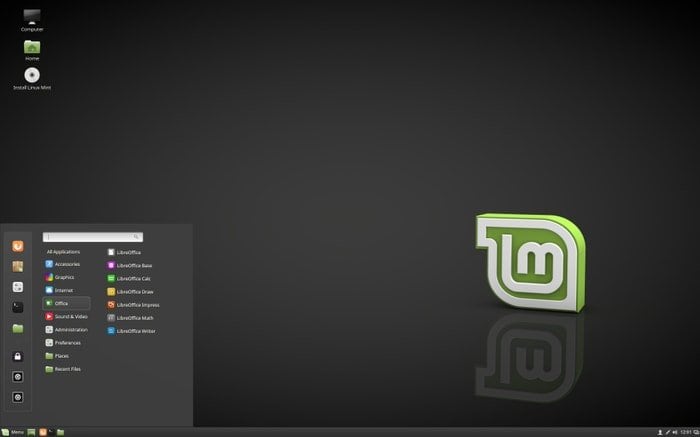
On the other hand, Ubuntu comes with default Unity like Gnome version besides with different desktop environments like Budgie, KDE, XFCE, etc. It provides a common dock-like panel at the right and a top bar with a notification area and an app window integration panel. You can find all the active app in the dock panel. This dock panel can be moved either bottom or left with a few tweaks via Ubuntu Gnome Tweak Tools.
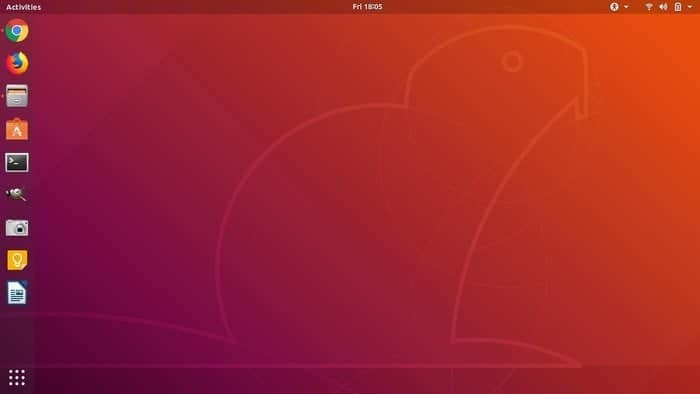
4. Performance
If we discuss the performance for both the Linux distros, Linux Mint will remain ahead of Ubuntu. Ubuntu default flavor is best suitable for modern devices with high-end hardware equipped. On the contrary, Linux Mint runs smoother on old equipment as well as a current machine. If you want to give life to your old dead laptop, I recommend using Lubuntu or Xubuntu flavor.
5. Software Manager
Both systems come with a complete software management system. Ubuntu Software center seems a bit slower and takes considerable resources to load. Comparing to that, the Linux Mint software manager is fast, quick, and straightforward. The distros provide various software under different categories, allowing the users to choose the right app easily.
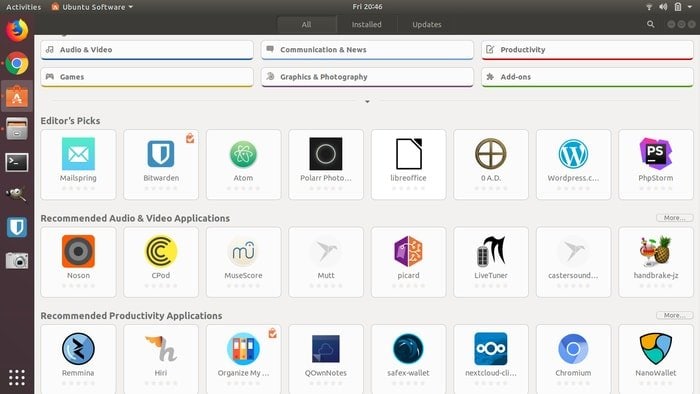
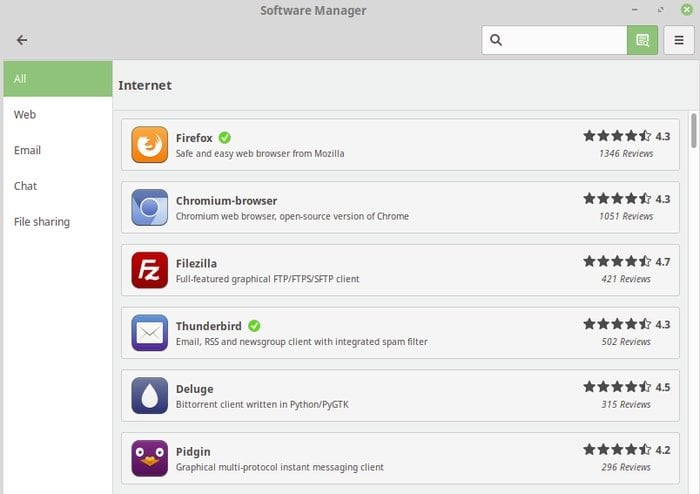
6. Software Sources with Useful Options
Linux Mint and Ubuntu come with software source tools or managers, but the one with Linux Mint is far better and offers more usability options for the beginner. Sometimes newbies messed up with the PPA repositories while installing some third-party Linux software. So the choice of resetting PPAs to default one comes in handy in this situation.
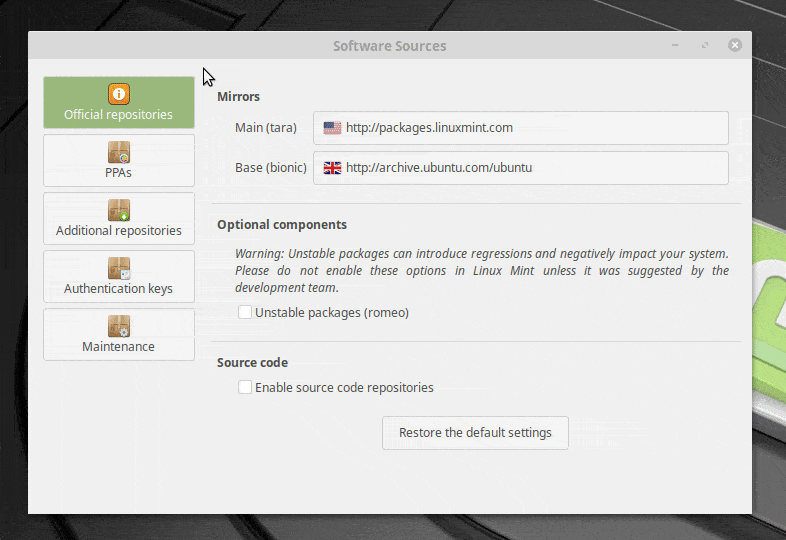
Only Linux Mint shines while offering these resetting options. Moreover, Linux Mint has a separate PPA management tab for easy control. Additionally, Linux Mint allows fixing various common update problems under the maintenance tab automatically. Ubuntu lacks all those nifty helpful options.
7. Necessary Software Out of the Box
What do new users want to do just after installing any OS? As a new user in the Linux community, you might want to enjoy movies and music, do some office productivity tasks in words, sheets, or excels, do web browsing, or do some photoshop job. All these are fundamental requirements for any user.
Recommended Post: Linux vs. Mac OS: 15 Reasons Why You Must Use Linux Instead of Mac OS
Linux Mint and Ubuntu both distros come with a set of default productivity applications. However, these distros also lack in some aspects. Linux Mint and Ubuntu don’t come with media codec or adobe flash if you have not selected them during the Ubuntu installation process.
Ubuntu has a package consisting of all the necessary media codec and flash, namely Ubuntu Restricted Extras. However, you will not get it on the software store; instead, you have to run the command into the terminal to install it. Initially, this process may seem a bit daunting for new users. On the other hand, Linux Mint also doesn’t come media codec, but it’s easy to find in the software center.
Moreover, Linux Mint offers some best Linux software like VLC and GIMP preinstalled that Ubuntu does not provide by default. You can install it afterward, but Ubuntu lacks behind by giving some essential apps pre-installed by default.
8. Linux Mint vs. Ubuntu: Beautification of GUI
Linux Mint does offer a better customization option than Ubuntu regarding the beautification of a graphical user interface. Though installing themes is not difficult on Ubuntu, you need a separate Ubuntu Gnome Tweak Tool to get more customization options for applying themes and icons.
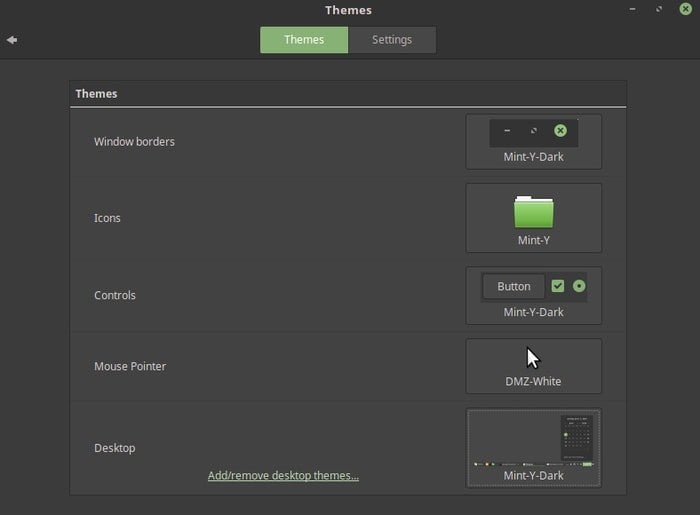
On the other hand, Linux Mint comes with a handful and nice-looking community-driven themes, applets, and desklets preinstalled. In Ubuntu, you have to find the Best Ubuntu Themes and Icons on the internet and download a zip file, then install it to apply. Ubuntu also does not support Linux Mint-like applets and desklets like widgets.
9. Linux Mint vs. Ubuntu: System Customization
Linux is impressive in the spare of customization. You can do whatever you want in the Linux system. It let you enjoy the freedom of customization. Ubuntu and Linux Mint are also not lag in customization.
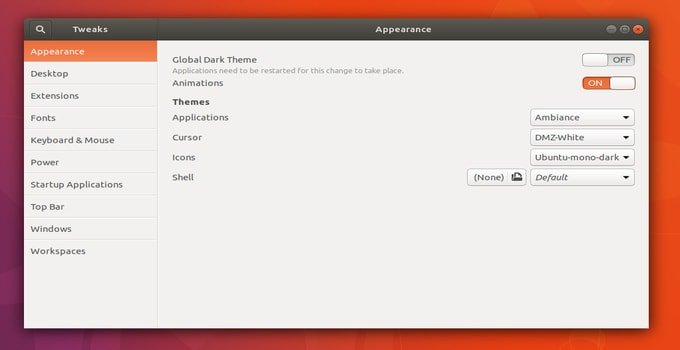
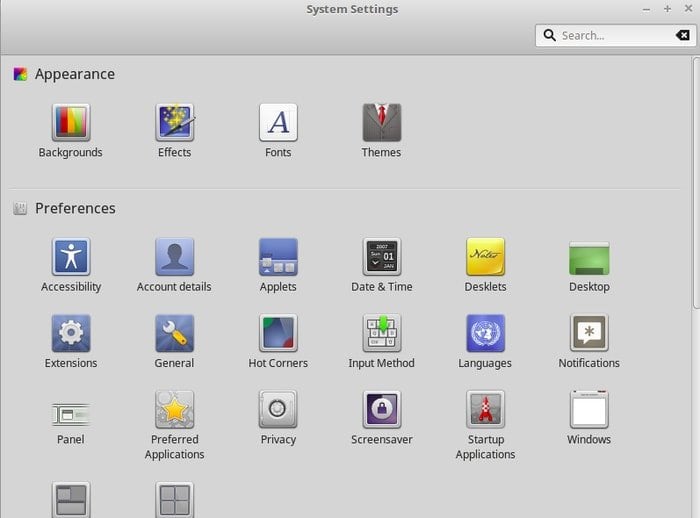
However, Ubuntu offers some preference, and it’s much more as “what you see is what you get” than Linux Mint. Time has gone a long way, and now both the distros let you modify the system starting from icons, menus, file systems, window management, and whatnot.
10. Various Desktop Environments
Ubuntu and Linux Mint both come with a set of different flavors. Now Linux Mint supports Cinnamon, MATE, and Xfce desktop environment. Recently it has abandoned KDE development. On the other hand, Ubuntu supports a wide range of Linux desktop environments, including Ubuntu Gnome (Default), KDE Plasma, LXDE, Budgie desktop environment, MATE, and Xfce. So in the case of various Linux desktop environments, Ubuntu goes ahead of Linux Mint.
11. Software Update and System Upgrade
Both the Linux distros provide a versatile way to update the application and upgrade the system into the latest release. Ubuntu has a software updater utility tool that checks the most recent app and system image release with just a single click.
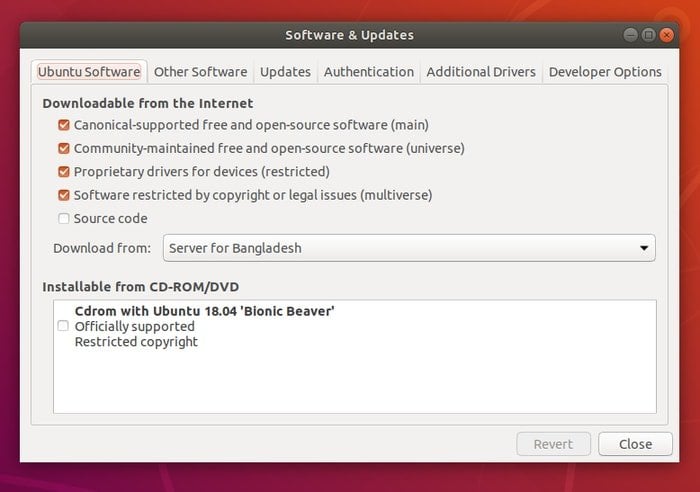
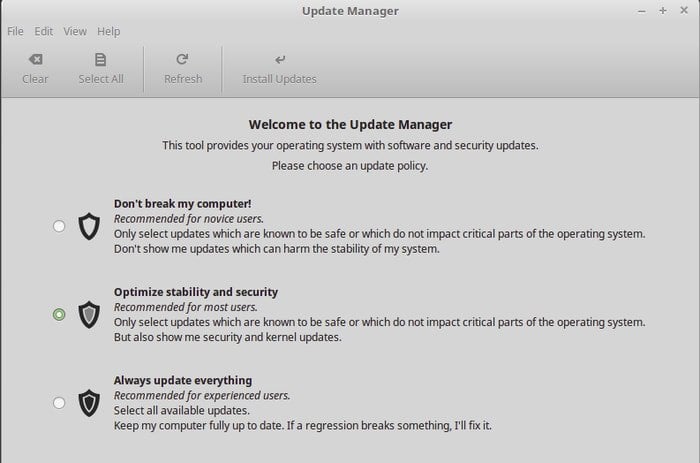
Linux Mint also provides a software updater for its app update and distro release upgrade. Moreover, you can also update the installed Linux software through a distro-specific software center in Ubuntu and Linux Mint.
12. Linux Mint vs. Ubuntu: Release Cycle
Every six months, Ubuntu releases a new version, and after every two years, It releases an LTS – Long Term Support version. Its LTS supports five years for desktop and server systems. So you understand now that the Ubuntu system release cycle is scheduled. However, Linux Mint has not planned; instead, it provides a new version after a few months when Ubuntu releases an LTS version.
13. Corporate or Business Use
Canonical is a great company and has made significant efforts to push its Ubuntu into corporate or business usage. The company is immensely successful in this sector. In this tech world, many servers are running Linux, and Ubuntu bites a large part of it. Moreover, many governmental authorities, including China, are converting their official system to either Linux or Ubuntu. Furthermore, Ubuntu could convince the PC manufacturer to pre-load its system onto desktops and laptops.
Recommended Post: Debian vs. Ubuntu: Top 15 Things To Know Before Choosing the Best One
On the other hand, Linux Mint is more aimed at enthusiasts. Apparently, Linux Mint has not endeavored to push its system into the corporate or business world. However, Linux Mint is polished and capable of replacing any OS or distros for any users.
14. Gaming Experience
Linux Mint and Ubuntu, both the distros, will have the same gaming experiences. However, as Linux Mint consumes fewer resources, running various games will give a bit more performance than Ubuntu. On the other hand, Ubuntu is an excellent choice for modern hardware so that gaming performance will be increased on Ubuntu with fewer compatibility issues. Finally, I can only say that gaming experiences will be more or less the same in both systems.
15. Linux Mint vs. Ubuntu: Community Support
If we discuss the community support, then Ubuntu remains a long ahead of Linux Mint. Ubuntu is backed up and developed by a large corporate company called Canonical and has a huge fan base and community-driven support teams worldwide. Linux Mint also does not lag. Many community groups worldwide and a group of companies using Linux Mint also act as partners, donors, or sponsors for its development.
Linux Mint vs. Ubuntu: Who Wins the Battle?
Personally, I like Ubuntu, but I also do not hate Linux Mint. It’s not a hate post towards Linux Mint or Ubuntu. However, a mere discussion and review on which factors we must consider while choosing the beginners’ right Linux distros. As a new user, I recommend using both of them and finding out which one fits your desire and needs. Linux Mint and Ubuntu are very popular in the Linux community and offer a wide range of software compatibility.
If you are an MS Windows user, then go for Linux Mint, which will give you a known desktop environment to play with but if you are a tech-savvy guy, stick with Ubuntu, as it provides a stunning and sleek system for your latest hardware.
Is Ubuntu is better than Linux Mint or vice versa? What do you think? Let us know your suggestions, experiences, and opinions in the comment below.
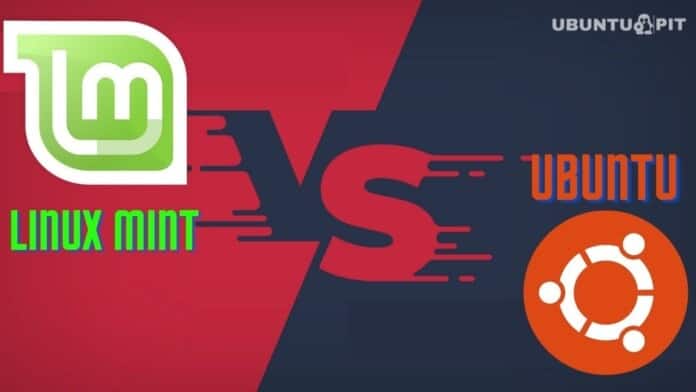
The basic thing is not discussed here: Legacy and UEFI.
The Updater in Mint has made a HUGE difference from the one in Ubuntu (and Lubuntu, Kubuntu, Xubuntu, etc). It allows me to update SELECTIVELY so I don’t get the high-risk updates that break stuff and make me have to chase them down and then “downgrade” the software that caused the regression. “Broken after update” is a recurring theme in the Ubuntu Forums.
I have been a Xubuntu fanboy for years now, but between the updates and the snaps deception, I’ve made the switch to Linux Mint Xfce flavor. I also really like the cool tools that Mint offers: Like MintStick, which lets me easily format USB drives and burn .iso files effortlessly with a sweet graphical interface. The only thing I’m adding to Mint is the Lite Tweaks tool from the under-rated Linux Lite distro, which even lets me purge systemd logs that ordinarily become huge after a little time.
I am with you there. Similar with upgrade experiences from UbuntuGnome 14.04 LTS (which is my fallback home) to Ubuntu 20.04 LTS.
Seems like everytime I reach a really comfortable and stable experience with an Ubuntu release, I am forced to upgrade because of so-called “End-of-life” lack of security and support. I truly would prefer it if Linux does NOT end up aping the Microsoft and Apple modus operandi and continues to be the magnifıcent alternative that it was designed to be.
Long Live Linux!
I’ve used both and like them both. I always come back to Ubuntu. It has just enough uniqueness to remind me that it’s not Windows for 95% of the time (the other 5% is when I’m forced to boot up Windows for whatever reason), and I’m always able to fix issues with a little help from my (online) friends. For my purposes they’re both rock solid and awesome.
I do prefer Linux Mint, because it always “seems” to be more bullet proof, but I’m moving on I think as of 20(.04).
The Reason? One very marked downside (at least to me) is that while the Ubuntu crowd genuinely seems interested in helping people, the Linux Mint communities are filled to the *brim* with arrogance, and it starts right with the developers. Unfortunate really, but there’s a knee-jerk defensiveness that lives deep among some linux collectives that the Ubuntu guys never seemed to exhibit.
Not sure how this happened, but Mint’s forum(s) seem to deserve this reputation (perhaps a kind of stackoverflow mental positioning?), and that’s enough to sway me away. Because (as with all of Linux) sooner or later getting through the day comes down to a highly esoteric question that needs to be answered.
Agree 100%. While the mint forum is useful there are some experienced people who are extremely arrogant on there and they are not controlled by those supervising the site. I suspect they’re quite young and immature. I have joined and left twice and now I don’t help out there at all but just search it for things I need.
You missed the 16th fact, which is the one that changed my choice: Ubuntu has (unfortunately in my mind) decided to use snap for some updates. Mint, which feeds off Ubuntu rather than Debian directly, has no plans to support snap. They admit that when some package is updated via snap, they will not be able to update. Thus, as the months go by, Mint will be increasingly left in the dustbin of running old code. One wonders when Mint will become so constrained by this deficiency that it will be completely useless.
Ubuntu Cinnamon Remix for me. Best of both
Is Linux safe to use just like a windows or mac machine ?
Ecommerce and banking. Was thinking of trying linux mint.
Yes
Linux is hands down safer than Windows or Macs. Having such a small market share decreases the probability of malware attacks, and being open source, there are thousands of eyes looking out for vulnerabilities.
Yes and no. Yes: Linux is safer because nearly no one targets it. No: “Open Source” (free or otherwise) does not in any way guarantee quality, and proper security is part of what constitutes overall quality.
The notion that open source by itself is better or safer (two distinct metrics) by the nature of the number of contributors is a myth that is best clobbered sooner than later. More often than not, I struggle with software laboring from poor design decisions that are the result of a committee approach, a committee mindset, and committee vagaries.
LOL. No.
Well, thanks u for your review. Yeah, I think both of them are very nice, but I have an other option in Linux Mint. Yes, it is an operating system for little old hardware, but if you use Linux Mint on that hardware, I think it’ll make your computer stuck for a long time. Not only Linux Mint but also Ubuntu and the whole Ubuntu-based. Sometimes, I work with my Zorin OS LIte but it sometimes make my computer stuck for some minutes. This is only my optional idea help you to make your post better if it is true. By the way, thank u for your post that I can exactly how to know what operating system I need. Hope you have a good day!
(If there are any problems with the grammar, words,… please tell me by mail and sorry for my bad English)
$ echo Thank u
I have always been a Windows user since xp in 2007. I loved it then, still do now 13 years later. Never could get it out of my head that Windows was meant to grow with me, and I started associating the best jobs a computer could do with Windows operating systems. I was introduced to the internet with it as a gold standard, which is why, when Windows 7 came out, and I heard about how it replaced Vista and the problems it had, I wanted in right away. Windows 7 impressed me because of the search tool in the start menu, however my first dislike of Windows came with 7 in regards to user account control and the new control panel format. I found out much later you’re not a admin but a hybrid user moderator type deal in Windows, and as someone who likes to try installing software, that really through me for a loop. It was then and there that I had to accept swallowing a hard pill, and that is, Microsoft is trying to decide what works best for me. Honestly the worst experience I had with 64bit architecture was in Windows 7 because everything would randomly disconnect. This is still the case today, and as a beta tester for Windows 10, resetting your DNS manually via command prompt became a daily occurrence just to reconnect to your Wifi and internet sites properly among other things. Forcing you to use troubleshooting wizards on a regular basis, was the first indication for me that no Windows is not the gold standard what so ever. But neither is Mac OSX. The problem with Mac is, everything Apple is restrictive by nature and when I discovered Mac, it was around the same time I discovered Linux. My introduction to Linux was on Cent OS where I spent a significant amount of time configuring server operating systems like Cent OS 6, 7 etc via SSH terminal. To this day I have a love hate relationship with the permissions system of Linux coming from Windows, where things are at least on the file management side of things, a little more intuitive if not relatively similar. Things are a lot better on Linux now than they were even 10 years ago. The truth is, what killed Windows entirely for me is that it wouldn’t install my sound driver for my laptop MSI GT680. Every Linux distribution I tried, Pop_OS, Linux Mint and other Ubuntu flavours recognized it instantly. It was then and there I knew without a doubt, my days with Windows are permanently over and what a relief it is now for me to say that. Some things Windows does better, like large file transfers, but in Linux, installing a better file manager fixes this out of the box. I can’t understand why people would use a piece of software like Windows 10 for example, where you want to fix a driver problem like installing Driver Pack Solution or even an Anti Virus and every piece of software you install is either full of ads, or puts unwanted junk programs on your system as a required dependency making your system slow and unusable. And then when that software fails to fix your problems, you’re stuck with the fallout of introducing it in your install. This isn’t the same thing like a wrong Linux upgrade, where you know and can pin point where something went wrong using terminal logs. In this sense, if you want a stable operating system that does what it says, and you don’t have to worry about issues like constantly having to switch to root to fix things, the most intuitive system I’ve ever used is Linux Mint. I have little experience with Mac, but I would recommend it over Windows any day especialy if you buy into IOS, the benefits of sync definitely are worth it however the draw back is non Mac software compatibility. The nice thing about Linux is that you don’t face these locked issues therefore making this operating system the choice of the future since times are changing and with them, decisions impacting everyone who uses platforms in the hands of people heavily investing into tyranical controlism among other problematic ideals. After all, a tool is only as good as its creation and how it is used outside of its native environment by its practical and unconventional characteristics driving the way forward. I want to experiment with Fedora, Arch and other Linux families, but I will always call Mint home for a reason. It works the way a computer is designed to, making you the user, front and center with whatever you want to use it for.
Ok, I can’t believe I wasted time reading this. “Driver Pack Solutions” <—Are you kidding me???? Of course you don't go running to 3rd party driver aggregates in the hopes that they don't fill things with malware.
Linux driver support is a complete nightmare!
Hey mate. Thanks for effort and time. I appreciate. In search for decent operating system after I realised win 10 many unlogical things, wierd preinstalled apps, in general is putting user on last place. And yes there you mentioned point I could not reach. That supposed to work how computer is designed to work! Thank you and have a good day
I was an avid Windows fan since Win 3.1, until the Win 10 fiasco. I had, over the years, played with Linux but found it had too many issues (for me) to bother with as a serious OS. That changed with Win 10, as it appeared Linux, at that point, was so much better. I have/had tested out hundreds of distros by then and found Linux Mint/Cinnamon to consistently work out-of-box while most of the other distros needed a lot of post install fiddling to get them working. My distro-of-choice became Mint/Cinnamon and I’ve stuck with it now for four years with not even a single issue, ever.
Thank you for sharing your expirience. Saving me much time/energy for further searching/decisionmking. Best regards
Comparing distros in Linux boils down to personal opinion and desires. As a 20 year user and supporter of Window, I can say after 10 years of Linux/Ubuntu there is no comparison between Win and Ubuntu. Ubuntu just works. No mandatory updates during boot. Amazingly fast boot times. Seamless backup systems. I could go on forever (or nearly). Bottom Line: (HATE windows – Love Ubuntu).
I find that I prefer linux mint over ubuntu. The main reason is that it is simpler for me when it comes to the installation of things like printers. Bluetooth and sound cards seem to work right out of the box too.
For some reason I just prefer the look of the mint desktop as well.
I agree. The way I see it is Linux Mint improved on Ubuntu LTS (that it’s based on) and Ubuntu improved on Debian (that IT is based on). Also, when I tested out the ‘buntu family I found Linux Mint/Cinnamon to consistently work out-of-box where most of the others needed post install fiddling (some more than others).
I’ve used both Ubuntu and Mint, and I prefer Mint. For one, I never liked the default DE in Ubuntu, and yes, it was nice to install a bunch of them, but I ran into more problems with Ubuntu than I did in Mint (I used Xubuntu from 2012 until 2016 if I remember well), and I think that Mint has a lot of really useful tools incorporated in it. I haven’t formatted anything for at least two years, even thought I have used TimeShift once to revert to the day before because I screwed something up. System still runs very smoothly and with very little clutter. I love the Mint updater, I find it better than Ubuntu’s. Driver management is quite good, too. And again, I really hate the default DE in Ubuntu, I never liked how empty and impractical it was compared to a more normal desktop where everything is close at hand and where the screen estate is used efficiently. I still run a baskc version of Ubuntu on one of my old laptops, as a web server with nothing else installed on it. But I hate how things are placed on the desktop. I know I can change DE or cutomize, but… This is a server. I don’t use it enough to customize it. But anyway, to each their own. Ubuntu is a good OS. I just like Mint better.
20 years of life with Linux….
I started my Linux experience with distro called Caldera around 1998. Then I was fascinated by SUSE and after few years moved to Ubuntu. In the meantime…I worked with HP Unix, Solaris, Sparc, Win95,98,NT,2000,2008,2012, Win7 and now Win10 / Server 2016.
It doesn’t matter what you have you just have to learn how to use it…
Today, @ home I’m on Mint not planning to change to anything else.
For me as Noob Linux Mint Cinnamon was a very easy step to switch to Linux. The desktop is very familiar and since most of the things that work in Ubuntu work in Mint {including the solutions} I had no problems.
I think this article needs some copyediting. The author uses the word “both” in a strange way (“both the system” instead of “both systems” as it should be). I’m not a native English speaker either, but that’s more of a reason to make sure the article is correct, so both native speakers can read it and English as a second language students are not distracted by weird grammar and do not learn bad habits.
Thank you for the valuable suggestion. The content is now corrected accordingly.
I Have two computers in my Home / Office. Main computer is Windows 7 Pro and the other is Linux Mint.
As a Hobby I do a lot of photography and use Photo Shop and Lightroom and they will not run on Linux. I have played with Gimp and it is not in the same league as Adobe products. I also have installed Windows 10 on a laptop and I am not a fan of it at all. I have until January to decide if I have to go to Windows 10 or a Linux Distro. If Adobe would make their products for Linux it would be a no brainier but that is not the case. I have found a program from Corel called Paint Shop that is made for Linux products and it works a little bit better than Gimp but again I favor Adobe products for photography editing.
No easy way forward I am afraid.
Maybe you are right. However, Gimp is damn close to Photoshop and you can’t argue about the price either. In combination with Krita and Inkscape, you get all that you would ever need for Photo editing.
Hi! Also doing quite a bit of photography here, and using Linux Mint as my main system and dual booting Windows for driver updates. GIMP vs Photoshop is an interesting one, as Photoshop has features included that are not included in GIMP but are available through other tools in the workflow. For example, I really like Darktable for editing my raw files, then export them and do further processing if needed (panoramas with Hugin, other manipulations with GIMP). One thing I would encourage you to do is to use the development version of GIMP (2.99), not the one included with Mint’s repositories. In terms of performance, it’s the same as Photoshop, with some features lacking (I wish GIMP had non-destructive editing), and more stability (I had PS crash on me way more often that I had GIMP crash on me).
I started Mint Mate when I was trying to get off XP. I edited the preferences and renamed “Menu” to “Start”. I’m not sure my wife knew I changed to Linux! I’m typically short on resources, so really like Mint Mate flavor. I appreciate that all versions are built off of the LTS ubuntu. I typically wipe my machines when I do a major upgrade; so have never had a problem I couldn’t work out. EUFI and GPT took a while to figure out; but I had to deal with them in windows too…
Seeing that Ubuntu is moving away from Unity makes me want to give it another try. I think they are also making headway in the IoT side. Also, I always load Ubuntu 18.04 on any of my Windows boxes using the Windows Subsystem for Linux. This greatly enhances my functionality in Windows.
Not completely Accurate. Mint also has a Linux Mint – Debian Edition ( LMDE ). This bases Mint on the Debian distribution rather than the Ubuntu distribution, and ensures that mint can continue if Ubuntu doesn’t. LMDE has most of the function of Linux Mint and has got even closer with LMDE4.
Ubuntu updates where scripts dont point to the new directories are extremely frustrating since it just adds another bunch of steps to troubleshooting. I first used Mint in 2009 i think, and it was way too light for a noob like me but I still played with it for about a month then switched to Ubuntu which was better (at the time) out of the box. Then I found beautifully simple Windows 7 and I went there.
I think Ubuntu is making the same mistakes Windows is in the sense that they want everyone to be the demographic. Taking more power away from users to make a hideous gui stay that way. Theres nothing personable about it anymore, if there ever was. Orange/purple migraine colors dont help.
Right now im running mint 19 from a live flash and its faster than my installed ubuntu and was able to stream media that I couldnt on ubuntu live disk.
And I agree with the above commentor that the Ubuntu community is vastily overrated. My questions are only answered with more questions even though I try to be as nuanced as possible, and then downvoted and lost in eternity behind more difficult questions like “How do you turn on the terminal”….
As soon as im done streaming this video im installing mint and never looking back. How can the derivative be so much faster, sleeker, and smartly designed?
Unity destroyed alot of support for Ubuntu, but now you have lots of choice. There is alot of value in ‘out of the box functionality’ especially with Ubuntu/Mint where upgrades can be problematic so better to do fresh install. I think Linux Mint with MATE desktop environment is the perfect office OS duento stability, out of the box functionality and especially with 19.0 just everything seems to work perfectly. As with others, Cinnamon doesn’t give me anything useful, and just uses more resources and used to be buggy.
Ubuntu occupies that weird situation as it is itself based on Debian, so it’s difficult to argue that the base system is better. Only thing I don’t like about mint is there are some high level arrogant people on the discussion forum, who admins often support, and they can make it terrible for everyone else.
I used to go for all the derivative versions until I realized if I like Cinnamon, as an example, I just hook up my Ubuntu installation to the Mint repositories and install it. Never really understood all us vs them. It’s all great!
Mint has never called my attention to try because of the Cinnamon DE style, yet I recommend it sometime for new comings to the Linux world.
Which you recommend – Fedora or OpenSUSE? which desktop – gnome or KDE?
not sure if the question is for me 😀 but I always recommend Ubuntu/GNOME. Then if the user is not that noob I’d go with Antergos or Manjaro. Because those have been distros that have provided the best experience in all of the aspects for me.
The question was for you but I forgot to mention you. Apologies for the inconvenience. I personally have experience of Ubuntu/Mint & would love to check Fedora/OpenSuse. But I’m not much familiar with the arch family.
I have never tried Fedora and it is because of the model to lunch new versions they have. With OSuse I had a terribly bad experience, I was starting in Linux and perhaps it was the reason why everything went to a mess. Maybe I’ll try it again in the future now that I have more Linux knowledge. And Arch for me is one of the best out there. Of course, that’s based ONLY in my own personal experience.
The MATE desktop is by far the best in mint. I too dislike cinnamon and feel that for ease of use, stability and functionality MATE is better for most people. I think the main reason people don’t use it is because Cinnamon is the default. Once you get used to a DE it’s also difficult to change.
Yes. It’s amazing how many tweaks you can accumulate in a couple years that are DE specific.
But even just starting fresh with a new revision of the *same* DE is nutty. I was just testing out MATE 1.24 in a VM and I was like “where’s this? where’s this? FFS, where’s this?” LOL….
I agree with the assertion that Ubuntu is a resource hog when compared to LM. I remember in the early Ubuntu days when it touted itself as a smaller, lighter alternative to the Giants of Windows and MacOS. Such isn’t the case anymore. It is sad to see that severely appealing promise dissolve.
Nice comparative article. I used Ubuntu for ~5 years. I hate gnome DE, so I switched to Linux mint 18.3 now 19 cinnamon desktop.
Few things I would like to share:
In Mint, you can choose wallpaper slideshow right from settings which I never found working in gnome tweak tool.
Few keyboard shortcuts in Mint are duplicated & you need to select the action whereas it’s easy in Ubuntu manually.
When you select properties of say music files, it doesn’t provide details like the artist, album in that field which you get to see in Ubuntu.
Dist upgrade is easy in Ubuntu while I had a painful experience in Mint 18.3-19!
I find Mint easy to use currently with a not significant difference between both.
I thought OpenSuse & fedora before choosing Mint, but I wasn’t convinced as felt both are crazy to install & use from a non-geeky view.
You do realize you can change DE without changing distros, right? I don’t mean that to be snarky, just legitimately curious.
Yes, but when I installed Ubuntu 18.04, I felt it wasn’t that good to use like 14.04/16.04 & I faced some problems with 16.04 LTS. At that time I wasn’t well versed with different DEs. So I just changed distro.
I still love Ubuntu esp 14.04,16.04 LTS but not willing to go back as I would need to reinstall a few apps. I would do that if I change my distro eg Fedora or OpenSuse which I may do after a lot of study & double checks.
I am loving Linux mint cinnamon and there is never been faced any problems, in the case of Ubuntu display problems are the first one to be encountered and after finding out the workaround you will face another problems which are really troublesome.
So in my opinion Linux mint is the best distro.
I use Linux Mint 19 and 18.3, both work well, I have used Ubuntu, and some lighter distros on the Raspberry Pi and Asus Tinker Board. For me it comes down to the target architecture, and since I have all older machines that are resource constraint I like the Mint distro, but if I was to get a new machine I would be installing Ubuntu. That said I do find most of my queries answered on the Ubuntu forum or Stack Overflow, anyhow I hope my 2 cents helps someone ?
I have to disagree with your position in regards to the community aspect. I tried switching from Windows to Ubuntu almost 8 years ago. I would post questions on Ubuntu forums and almost every one went unanswered. I ended up going back to Windows. Mind you, I’m a fairly tech savvy user. I search forums for answers to questions before I ask. Fast forward to about 2 years ago, I decided to try out Mint. I ran into similar problems as I did with Ubuntu. The only difference was that the community answered closer to 95% of my questions. I haven’t touched Windows since. On top of that, since people have answered my questions, I’ve learned a lot about how Linux works and have, in turn, helped a few people on the forums along the way. And now that I’m more comfortable with the file structure, kernels, update processes, package managers, etc, I’ve started experimenting with Arch and Fedora. The bottom line is Mint definitely has a much more active, albeit smaller, community.
You compared OS support for two flavors, but the support was separated by EIGHT years of community evolution. Did you try Ubuntu at the same time as Mint?
Linux Mint is better, it has all the VPN stuff built in, loads of stuff just works straight after install